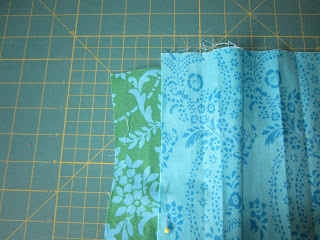1. When did you start designing
patterns and how did it come about?
My
very first pattern designing was WAY back in college...ahem...I mean, just back
in college as I majored in Fashion. Of course, technically, I was designing
clothing and the patterns were just a means to that end. I was actually very
uninterested in patternmaking as a profession back in those days...too much
math.
2. What training do you have or how did you learn?
I
was trained in school but I spent many years NOT making patterns, afterwards,
and I do not believe it's like riding a bike. I had to do some major refreshing
when I decided to open up shop. Crazy enough, when I worked as a designer I was
always happy that I didn't have to actually make the patterns but now I truly
enjoy the technical aspect of it all and it's so rewarding to see all those
lines and measurements become exactly what I hoped it would when the piece is
finished! Maybe I like math, after all?
3. What is the process of designing a new pattern like?
First
a simple idea comes to me. This is usually about 2 a.m. and keeps me awake for
an hour or two. Then IF I remember it in the morning it gets sketched in my
book or on a napkin or whatever I can find lying around. In this house, it
often gets sketched with a crayon. Most ideas/sketches never even make it out
of the book but if they do the next step is drafting the pattern onto freezer
paper. I then make a bunch of samples. These are usually in a size 3 and a size
7 because those are the sizes my girls now wear. They get to try everything on
a bazillion times until I get it just the way I want it. After I'm happy with
the fit I scan the freezer paper patterns into the computer and clean it all up
and work on the grading on the computer. Then there's shooting/writing the
tutorial and my sweet graphic artist husband pretties it all up. After that it
is off to testing and crossing my fingers that any changes are easy.
(Note: this is one of the MOST well reviewed patterns I have seen! There is a lot of love, on Facebook, for this pattern.)
4. What is the hardest part about designing a pattern in pdf form?
Keeping
it simple, I think. Many PDF pattern customers are beginners so I find it
challenging to keep the design simple enough to be easy to sew and the explanations
plain enough that someone brand new to sewing can understand it. When you've
been sewing for more than 20 years it can be hard to get back into
"beginner brain" and I am very concerned that I don't frustrate my
customers.
5. What is your favorite of your
patterns and why?
I
still love the Rings of Ruffles Pants. Out of all the clothing I have made my
own girls they are still my favorite to watch them run around in. They
instantly make any of their outfits that much cuter.
6. Do you sew for your own family or
for sale? What do you prefer more, sewing or pattern design, and why?
I
love sewing for my family. I no longer sew items to sell. Any creative time
that is left in my days beyond running LilyGiggle I like to devote to making
things for my own children and home. I've got 4 of them and one on the way so I
could sew all the time for them.
7. Have you learned anything from
feedback from customers that you would like to share with other designers or
wanna-be designers?
Oh
boy have I learned a lot from my customers! I know that my customers love a
design that whips up easily but still looks awesome. I try to eliminate too
many fussy details but still keep enough detail to make it interesting. Details
in the tutorials are super important, too. That's what makes most PDF patterns
so much better than the big box store patterns...the details and photos that
make all the steps easy to understand. Also, customers want lots of sizes to
choose from. It is way easier to grade just a few sizes but taking the time to
get a full size range created makes a huge difference to customers.
(note: You have probably seen these pants everywhere! This pattern is that good!)
8. Best time and place to design?
When kids are sleeping, of course.
9. Favorite fabric of all time?
Impossible...like asking me who my favorite child is!
10. Favorite thing to do for fun?
I
live in one of the most beautiful places in the world (in my opinion) nestled
in a great town surrounded on all sides by mountains. My favorite thing to do
for fun is to get out in all that gorgeousness. Give me a picnic blanket, some
yummy food and a sunny day and I am one happy girl.
Stay tuned for a few more pattern designer interviews to come.......





















































